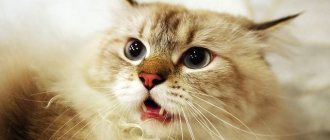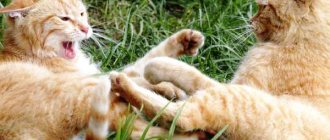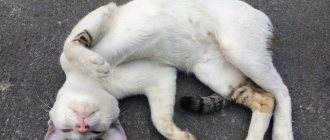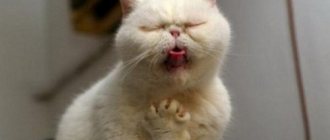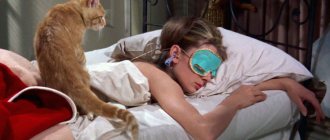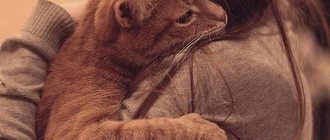Cat
is a natural predator, but her skill
as a hunter
is not at all determined only by innate instincts. She acquires many skills by watching other cats, and then hones them through her own experience. A cat, for example, does not easily learn the art of catching birds - before mastering it, she has to practice for a long time and thoroughly.
The training of the kitten by its mother and other adult cats plays an important role, and good students, as we know, come from a good teacher. Descendants of non-hunting cats rarely become dexterous hunters; this may be partly determined genetically. As for hunting
, then
cats
inherited them from their ancestors who lived in forests, and therefore prefer to watch and ambush prey rather than chase it.
Even the best mouse catchers don't kill every single one of their victims. Observations showed that almost half of all mice avoided cat paws. However, putting aside the unnatural disgust that some of us feel when someone dies (even if the death is the result of natural instincts), a trained cat is on the hunt
truly worthy of admiration.
Who do cats hunt?
The most typical prey for a cat is a mouse and other small mammals: shrews, moles, etc. Often rats, rabbits and hares become victims of cats. Much less common are adults of these species, as well as squirrels, weasels and bats.
Birds are often harmed by cats, but according to research, they are rarely eaten. Apparently, cats hunt birds solely for the love of art, for the sake of entertainment.
But snakes and lizards are a typical part of a cat's diet, especially in areas where these animals are found in large numbers. In the Middle East, cats are often used to protect against snakes.
Amphibians and insects also often become cat prey, and not always useful.
Most cats do not engage in fishing, but some animals living near bodies of water rich in fish resources can learn to fish. Cats can also steal fish from fish markets, from fishermen and from nets if they live on ships. However, this does not mean that fish is a natural food for a cat.
Cat hunting
Natalya Reznik, Candidate of Biological Sciences
“Chemistry and Life” No. 3, 2020
The cat's shadow hangs over the world. This image is obtained by a camera mounted on the neck of a predator walking along the wall.
No matter how much you feed the cat, he will still hunt. Because cats are predators, so successful and all-consuming that they are included in the list of the hundred most harmful invasive species in the world. This means that wherever these animals - natives of the Fertile Crescent and Egypt - were brought, they settled in, multiplied and now threaten the local fauna.
The domestic cat is the name of a subspecies of the forest cat, Felis silvestris catus.
, but is by no means a characteristic of a lifestyle.
Many F. catus
actually live in houses, while others have become so wild that they avoid people. The degree of harm caused by cats depends on their relationship with humans, and experts who study the impact of cats on wildlife always specify which category they have in mind (Fig. 1). One cat, forced to provide its own food, kills hundreds of animals in a year. This would not raise much objection if he only exterminated wild rabbits, rats and mice. But cats successfully hunt songbirds, and many feel sorry for the birds. They have also contributed to the extinction and decline of hundreds of species, including in the Pacific Islands and Australia.
Rice. 1.
The degree to which cats are domesticated depends on how much control a person has over different aspects of their lives: reproduction, feeding and movement. The group of free cats includes animals that spend most of their time outside. These can be either rural cats with owners or ownerless animals. They get their food by hunting, and people - owners or compassionate lovers - feed them. It is unrealistic to fully control the reproduction of such animals, that is, to select a mate for them; can only be sterilized
We will often think about Australia, because white people brought there many animals with which they are now suffering. In particular, the continent is burdened with rabbits, which devastate the local environment. There are especially many of these animals in the south of the country, where they form the basis of the cat’s diet. Well done cats! But when there are a lot of rabbits, the number of predators increases, and the more there are, the more damage they cause to the local fauna, and this is already bad. If the number of rabbits decreases, cats also become less numerous, but they pay increased attention to Australian small marsupials. In the north, local rodents, reptiles and marsupials are better preserved than in the south, and there they, rather than rabbits, become the prey of cats. Overall, native species make up more than half of the diet of Australian alley cats. Since 1788, when the British and cats first set foot on Australia's shores, a tenth of the 273 endemic land species there have become extinct and a fifth are threatened with extinction.
Of course, other introduced species are also predators in Australia: dogs and red foxes. Cats are not inferior to them in terms of productivity, but they prefer smaller prey. Another Australian scourge is land clearing, which kills up to 900 thousand mammals every year. This is much less than the 509 million mammals killed by Australian cats, but such a comparison is not entirely correct. Clearing the area results in permanent loss of habitat, and significant annual damage from cat hunting may not be so bad in the long run.
The hunting activity of free-ranging cats is impressive, and only recently did researchers realize that domestic pets also hunt for prey. And although they destroy tens of times less living creatures than homeless animals, there are so many of them that the total damage is impressive. Even one animal can do a lot of things. Several years ago, a neighbor's cat or she-cat got into a garden in the suburbs of Perth (Australia) - observers did not determine the gender. In this garden lived 40–50 small lizards, skinks Ctenotus fallens
. Within a few months, the cat destroyed almost everyone. The owners tried to drive it, but to no avail. He persistently came at night, was not afraid of either water or dogs. Two years later the cat moved. By that time there was not a single skink left in the garden, and for another six years they did not inhabit this place. Fortunately, this species is not in danger of extinction.
The cat will find a way to hunt without even leaving the house. One Siamese whim, who spent her whole life within four walls, organized a mouse for herself in the bathroom of a Moscow apartment on the second floor and had a lot of fun with it. However, it didn’t come down to food - the catch was taken away by the owners with apologies and thrown into the garbage chute.
The damage caused by domestic cats is often downplayed. Usually he is judged by the prey that proud cats bring home. However, special studies show that animals show their owners no more than a third of hunting trophies.
It is generally accepted that a predator kills when it is hungry, so a well-fed domestic animal that comes out to stretch its paws does little harm. Alas, this idea is not always true.
Back in 1979, University of North Carolina zoologist Maxine Biben observed a cat playing with live prey. These were strange experiments. They involved eight animals that were born in a house or laboratory and were able to catch mice. They were individually imprisoned for 15 days in a room made of concrete and cinder blocks measuring 2.77 x 2.87 meters. Lamps and all the necessary equipment were mounted on the walls, a tray, bowls of food and water, and a place to sleep (one would like to call it a “bunk”) were raised above the floor. The room was separated from the outside world by a sliding curtain through which one could look inside and throw a mouse or chicken in. Immediately before this, the cat was fed to its fill. Over 120 days, eight well-fed animals committed 71 kills, barely leaving the bowl; 84% of murders ended with the victim being partially or entirely eaten. In this case, the next mouse was pushed into the chamber. Usually the cat killed her too.
In addition, the researcher observed the behavior of cats in natural conditions and in spacious cages in the fresh air. She noted that a hungry predator kills its prey immediately, while a well-fed one “plays” with it—either tossing it up, then biting it to death, or letting it go for a while to catch it again. Perhaps the game allows the cat to study the prey: to become excited in order to kill, or to retreat if the prey turns out to be too large and aggressive. So, a rat weighing 150 grams is a serious opponent for a cat. As a result, Maxine Biben came to the conclusion that well-fed predators do not kill after all. It’s just that her subjects, imprisoned in a concrete chamber, found themselves in an unnatural situation, when there was a lot of prey and nowhere to go. And since a live mouse is a strong irritant for them, they became overexcited and continued to kill.
But firstly, a wounded animal that escapes from a well-fed cat will very likely die from injury, loss of blood or infection in the wound. And secondly, the abundance of prey awakens hunting passion in cats not only in a concrete chamber. Several years ago, scientists studied the population of New Zealand short-tailed bats. These animals gather in huge colonies and are therefore easily vulnerable. In general, cats often catch bats when they fly low over the ground, feed, or climb into their shelters. A colony of bats is easy to spot - it is noisy and odorous. However, in New Zealand cats do not hunt bats. In any case, scientists thought so until they observed two colonies of short-tailed bats in the Rangataua Forest on the slopes of Mount Ruapehu.
The mice nested in the hollows of trees located 15 meters from each other. One hollow had a large open entrance at a height of five meters, the other had a smaller entrance, 30x15 cm, six meters above the ground. One morning, researchers found 86 mouse wings and one carcass under the trees, the next day - 6 wings and 19 bodies with signs of violent death. Video cameras and a trap for small animals: rats, stoats and weasels were installed near the colonies. The cameras did not film anyone; a female ermine fell into the trap, but she clearly had nothing to do with it, and meanwhile another mouse body and 26 wings appeared on the ground. They found cat fur at the crime scene, so they set a special trap and caught the small cat. His stomach contained only rabbit meat (bait), but the fur matched samples previously found near dead bats, and the distance between the fangs matched the teeth marks on the corpses. After the cat was captured, the killings stopped, but in seven days he managed to kill at least 102 animals, if we assume that two wings belong to one individual. It is unclear how he caught them, because the cameras did not record him.
It is worth saying a few words about the size category of cat prey. Many researchers note that cats prefer animals lighter than 35 grams. Perhaps the fact is that small animals are fertile, there are many of them, and the cat is more likely to encounter them. However, Australian cats, although they do not disdain small things, clearly prefer prey weighing from 300 to 550 grams, otherwise how would they hunt rabbits? In addition, their menu includes representatives of 19 species weighing more than two kilograms. It is possible that they prey on larger animals, but these cases may be overlooked if such animals are rare or occupy a limited range.
In general, things are bad. Both hungry feral cats and well-fed domestic cats hunt successfully and mercilessly. The annual martyrology of cat hunting victims reaches hundreds of billions, and something must be done about it. The administration takes action regarding stray cats. In the worst case, they are killed; in the best, they try to create territories free from these predators, for example, they are evicted from the islands. In cities, stray cats are the most numerous predators, and to reduce their numbers, many countries have adopted a “catch, sterilize, and return” strategy. This is an ambiguous measure. Neutered animals live longer, males fight less and therefore suffer fewer injuries. But still, the number of stray animals is gradually decreasing.
On the other hand, many perceive street cats as part of urban nature. And it is customary to love and admire nature. In cities such as Rome, Venice or Istanbul, cats decorate certain squares and streets, and the people who take care of them form associations, cooperate with the local veterinary service, and sometimes receive a salary. It could be argued that the activities of cat lovers undermine efforts to reduce their numbers, especially in warm climates. But a satisfied cat pleases the eye and hunts less actively, and feeding cats is excellent therapy. Feed them, feed them.
Owners are responsible for cats that have owners. It is they who must make sure that their pets do not hunt anyone they shouldn’t and generally wander around less. The cat is capable of causing significant damage with its mere appearance. Several years ago, specialists from the Universities of Sheffield and Exeter (UK) made stuffed rabbits, a cat and a gray squirrel and placed one each next to a blackbird’s nest. The birds were not afraid of rabbits; the stuffed squirrel irritated them, because gray squirrels destroy birds' nests. But, seeing the cat, the blackbirds raised a cry, circled over him, dived and tried to drive him away. The researchers removed the motionless figure of the cat after 15 minutes, but even after an hour and a half the blackbirds could not calm down. All this time, they brought their chicks a third less food than usual, which can reduce their growth rate by 40%. And the commotion caused by the appearance of a stuffed cat attracts the attention of real predators. The next day, crows visited the thrushes' nests.
It is possible to persuade the owner to limit the movements of his cat only when he realizes the seriousness of the problem. Residents of Australia and Tasmania, where cats run rampant with horrific consequences, agree to register their pets (registration increases the sense of responsibility), sterilize them and lock them up at night. However, measures such as a complete ban on keeping cats or keeping them indoors 24/7 do not find support even in Australia. Residents of other countries are much more carefree. Thus, more than 60% of Britons do not believe that cats pose a threat to wildlife. And conservation organizations in the United Kingdom share this view.
According to British laws, the cat owner is obliged to provide his pet with the opportunity to lead a natural lifestyle, that is, to walk and hunt, so domestic cats have every right to roam around the area. At the same time, they are considered the property of the owner, and property is not responsible for breaking into someone else’s home, damaging property, fighting with a neighbor’s cat and eating his favorite canary. If the angry canary owner decides to punish the uninvited guest, he will have to answer to the law. The cat's owner is innocent of his actions. If he compensates for the damage caused, it is only because he wants to maintain good relations with his neighbors.
Recently, experts from the University of Exeter, led by Professor Robbie MacDonald, surveyed 48 British cat owners living in rural areas and found out their attitudes towards cat predation. Some approved of it. If a cat hunts, it means that she is comfortable, and hunting trophies indicate the cat’s professional suitability, of which the owner is proud, like Carroll’s Alice: “It’s a pity that I can’t show you our Dina. If you only saw her, I think you would fall in love with cats. She is so sweet, so calm... She sits by the fireplace, purrs and washes herself. And so soft, you just want to pet it! And how she catches mice!
Others reasonably believe that predation is an integral feline trait. If someone doesn’t like her, then there’s no point in getting a cat. Not everyone follows this advice. They take a sweet, calm and soft animal into their home and suffer because he is such a monster. It is especially unpleasant for such people when a well-fed cat hunts, showing unnecessary cruelty. However, they are concerned with the suffering of the individual victim, not the fate of populations. They do not consider domestic cats a threat to wildlife, and certainly not the most important one.
Those who are concerned about the number of wild animals usually worry about birds. The survey participants found it difficult to explain why specifically about them. Perhaps because birds, unlike mice, did not bother them as pests. And small rodents - don’t they exist so that cats can catch them?
There are, of course, those who consider hunting a personal problem. Cats bring dead and half-dead prey into the house, which is very unpleasant. One of the cat owners woke up at night because a vole was running through his hair. At the same time, prey in the house is perceived as an inevitable consequence of living with a cat. And finally, the extreme point of view is that domesticated animals should not be predators at all, even cats. It's unnatural.
And then Robbie McDonald asked his respondents the following question: are people responsible for the behavior of the cats they domesticate? Even those who do not approve of hunting say no, they do not answer, especially since the cat cannot be controlled once it is out of sight. He's so independent. Unlike Australians, the British are not ready to deprive their cats of the natural right to roam and hunt freely. And even the thought that a free-walking cat could get hit by a car will not make them change their minds. Independence and freedom of movement are an integral part of a cat’s attractiveness. Other owners note that their cats, which used to roam freely, become stressed after being confined at night. And if a cat is kept specifically to hunt rodents, no one will lock it up. In general, most Englishmen, unlike Australians and Americans, consider it unethical to restrict cat movements.
Perhaps people who keep cats don't consider them dangerous to wildlife, and those who do don't. It is not yet known how cat ownership fits into this point of view. People who feel sorry for the bird try to save it if they see it alive in a cat’s paws, scold their cats when they catch them in the act, and splash water on them. Some people removed bird feeders so there would be less prey in the cat's range. Others, on the contrary, feed the birds, hoping that with an abundance of game the predator will lose interest in it. Now is the time to remember the killer from the Rangataua forest. According to some reports, cats can be distracted from hunting by an abundance of toys and time spent with the owner, but not everyone shares this opinion.
All of the above applies to limiting the cat's freedom. Is it possible, without preventing the animal from walking, to prevent it from hunting? Experts have been seriously studying this issue for several years. Typically, cats are wearing a collar with some kind of device attached to it. For example, a bell that attracts attention to a predator. Many owners who have equipped their cat with a bell have found this measure to be effective, while others consider the collar useless: cats can easily remove it or learn to walk silently, despite the bell. In addition, continuous ringing irritates cats, they experience stress, and some animals are injured due to the collar.
Naturally, the owners are primarily concerned about the safety of their cat, and not the tit, which he scares and catches.
In Australia, the problem of collars is being studied by specialists from Murdoch University under the leadership of Associate Professor Michael Culver. They rejected bells as ineffective, but there are other ways to attract everyone's attention to the cat. One of them is special bright collars that are clearly visible to birds and lizards with color vision. Most non-primate mammals have poorly developed color vision. The collar is a tube of brightly colored fabric that is placed over a regular cat collar to create a puffy collar about 5cm wide (Figure 2). There is a reflective strip along the edge of the collar. The collar was developed and patented in the USA, and is also protected by patents in 28 other countries, but who is stopping anyone who wants to make such a thing themselves?
Rice. 2.
A bright collar makes the cat noticeable, and a bib prevents him from hunting birds
The collars were tested on 114 domestic cats living around Perth. In the first year, they wore devices in three colors: red, yellow or rainbow. They all worked, especially the rainbow and red ones. The red-collared cats brought home just a third of the usual number of mammals killed over six weeks, mostly house mice and black rats, 41% of birds and 36% of lizards. The indicators for the rainbow collar were 50, 28 and 4%, respectively, and for the yellow collar - 58, 54 and 20%. Let's be honest: we don't want cats to stop hunting altogether. Let them continue to catch rats and mice, but leave the birds and lizards alone. A rainbow-colored collar is best suited for this purpose. They continued to work with it, and according to the results of two years of testing, the rainbow collar reduced the catching of prey with good color vision by approximately half. The researchers hoped that two years of unsuccessful hunting would discourage the cats from predation, but this did not happen.
Now for the good news. Most of the cats quickly got used to the new collars, only two did not adapt. Sometimes claws or teeth get stuck in the collar, but there have been no incidents that require veterinary attention. True, cats in collars were sometimes not liked by the dogs living in the house, who barked at them.
The birds, seeing the cat in the rainbow collar, remained in the trees, and the lizards froze in place. One owner kept a cockatoo at home, which was terribly annoyed by a cat in a collar - the bird screamed shrilly incessantly. For the sake of general peace, the new thing had to be removed. Despite some unwanted side effects, 77% of owners planned to use the collar after completing the study.
Another option that Michael Culver and his colleagues tried was a brightly colored bib (Figure 2). It is made of neoprene, lightweight, durable, flexible and easy to clean. It is attached to the front of the collar using a hook and Velcro. The cat can move the bib when washing itself, then the device returns to its original position. The bib does not prevent cats from running, jumping, climbing trees, eating, picking up toys from the floor and carrying toys. But the bib does not allow you to catch birds.
Cats perceive a bib worse than a bright collar. In the first days they rush around like crazy, trying to get rid of it by any means. If it is poorly fitted, they may trip over it. However, the bib protected 81% of birds from cats, but, alas, only 45% of mammals and 33% of reptiles and amphibians. Half of the owners thought the bib worked, another half found it useless, a few were undecided, but still 70% planned to continue to burden their cats with this device.
Most often, people agree to dress their pets in bibs and collars out of concern for the environment. Sometimes they are forced to do this by moral suffering caused by the atrocities of the cat, or simple curiosity - what will come of it? And it turns out that deterrent devices approximately halve the effectiveness of cat hunting. But this is not enough. To protect the world around you from cats, you need to prevent them from wandering wherever they please. Neither collars nor bibs are capable of this - Michael Culver specifically tested it.
Let cat rights activists think that a night arrest or a high fence around the garden reduces the threat posed by cars, fights with other cats, and encounters with foxes and coyotes who are not averse to hunting cats. Environmental measures benefit everyone, including cats.
How do cats hunt?
Cats have two hunting strategies: ambush and stalking. That is, either the cat, by smell, finds a hole or path on which prey may appear, and patiently waits for it, counting on a successful jump.
Or the cat tracks prey (most often by ear) and begins to sneak up on it. Sneaking, the cat slides in the grass, pressing its belly to the ground and using all natural shelters. Alternating between runs and stops, the cat approaches the prey within a jumping distance and stops. She moves her paws and twitches her tail to better time her jump. Then comes the final rush, when the cat jumps on the victim with its front paws and pins it to the ground to make it easier to deliver a fatal bite.
Cats bite their prey at the place where the skull meets the spine, breaking the animal's spine. If a cat is hungry, it will swallow small prey whole, and eat large prey gradually, starting from the stomach. This is what lions do in the savannah, eating buffalo or antelope. If the cat is not hungry, then it can play with half-dead or dead prey for a long time, sometimes the prey can even be saved during this game.
Oh, I got a bird
Bird hunting is not an easy task for a cat!
However, among cats there are even some intellectuals who cannot stand the smell of mice, preferring to feast on birds. And they succeed!
It turns out that catching a mouse costs a cat almost nothing. It's a bird! That one's eyes are positioned in such a way that you can see what is behind. If a cat can still grab a gaping bird located on the ground, then there is nothing to think about catching prey sitting on a tree. True, you can sometimes walk through bird nests.
When do cats hunt?
It is believed that the average cat needs 8 mice per day for food. At the same time, cats hunt only at dusk, before sunset and after dawn. Thus, cats living outside need to hunt intensively for 3-5 hours a day.
At the same time, well-fed cats can hunt even better than hungry ones. The goal of a hungry cat is to get enough, that is, after catching its 8 mice, it will go to bed. But a well-fed cat will catch mice and birds for its own pleasure. She won’t even eat them, since there is more than enough energy, and it needs to be thrown out, not earned.
Right choice
It is almost impossible to determine the character of a kitten at a young age. Temperament is immediately visible, because there are active and passive kids, curious and cunning. But this applies only to the properties of the breed, and gender does not affect the character of the animal in any way. Adult cats behave differently, some are distinguished by cleanliness and independence, others by laziness or affection.
